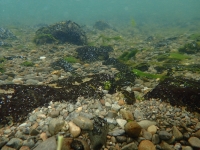I want to...
Current filter: Most popular
A to Z
Apply for a job
Biosecurity
Consents
Consultation
Contact Us
Environmental Data
Farmers Hub
Fix it or Report it
Information Request
Join an Event
Leasehold Land
Meetings
Rates
Water Metering
Have Your Say
Take Care with Dogs by Rivers
Published: 4 December 2017

As rivers warm up and water flows reduce, Hawke’s Bay Regional Council is reminding dog owners to keep their dogs under control at the region’s braided rivers because of the risk of the potentially toxic cyanobacteria, Phormidium, being present.
Phormidium occurs naturally in stony rivers where it forms a soft, blackish mat on rocks. These can be washed off and dry on river banks where they look like dried leaves or cow pats. It poses a health risk to people and dogs as it can turn toxic, although when and why that happens is unknown, so it should always be treated as a potential health hazard.
“Science still cannot tell us what triggers Phormidium to start to produce toxins. We can’t predict it so the best advice we can give is to treat all black mats on rocks in the water and drying mats on the banks as potentially toxic,” says Anna Madarasz-Smith, HBRC’s water quality scientist.
Phormidium regularly affects parts of the Tukituki, Ngaruroro and Tutaekuri in summer. It is different from the harmless bright green, stringy algae that also increases in our rivers in the warmer months. Hawke’s Bay Regional Council environmental science staff monitor parts of these rivers where Phormidium has been known to thrive, but cannot monitor the entire rivers, so people need to know what to look for.
“Because our staff simply can’t be everywhere on the rivers, people need to know what to look for and to avoid. We’d really like people letting us know quickly when they see the mats in a river so we can alert other river users,” says Anna Madarasz-Smith.
Phormidium occurs in parts of back country rivers as well as low land rivers, and in clean water.
Dogs appear to be attracted to the drying mats, and are known to get sick from either investigating the mats or drinking water with Phormidium in it. A dog died last summer after being at the river although it was not conclusive that this was linked to cyanobacteria.
“Vets tell us that it’s not a clear cut diagnosis to make the link with Phormidium ingestion, as the symptoms of Phormidium poisoning in dogs closely resemble heat exhaustion,” she said.
The best advice for taking dogs walking at the river during summer –
- Keep dogs under control at all times. Don’t let dogs drink from the river during summer, and don’t let them investigate the weed mats.
- Take a bottle of water and bowl for the dog to drink from, especially if you are by the river for some time. Give your dog some shade to cool down.
- Give your dog a good drink before you leave home.
Dog owners should take their pets to a vet quickly when they show any unusual symptoms or behaviours. Hawke’s Bay Regional Council has contacted local vet clinics with information about Phormidium and some guidelines about how to contact the regional council’s environmental science team if any dogs are presented with illness after being at a river.
The water quality monitoring programme is managed jointly by Hawke’s Bay Regional Council with the Public Health Unit of Hawke’s Bay District Health Board. Local councils also take a role in ensuring the public are well-informed about water quality.
HBRC Photo: Black Phormidium mats and harmless green filament algae in a river
Disclaimers and Copyright
While every endeavour has been taken by the Hawke's Bay Regional Council to ensure that the information on this website is
accurate and up to date, Hawke's Bay Regional Council shall not be liable for any loss suffered through the use, directly or indirectly, of information on this website. Information contained has been assembled in good faith.
Some of the information available in this site is from the New Zealand Public domain and supplied by relevant
government agencies. Hawke's Bay Regional Council cannot accept any liability for its accuracy or content.
Portions of the information and material on this site, including data, pages, documents, online
graphics and images are protected by copyright, unless specifically notified to the contrary. Externally sourced
information or material is copyright to the respective provider.
© Hawke's Bay Regional Council - www.hbrc.govt.nz / +64 6 835 9200 / info@hbrc.govt.nz


